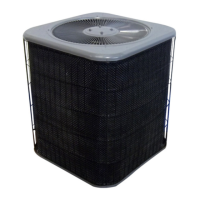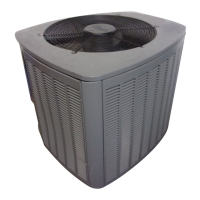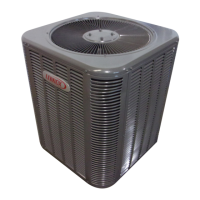Page 8
5 − Evacuate the line set and indoor unit to an absolute
pressure of 23,000 microns (29.01 inches of mercury).
During the early stages of evacuation, it is desirable to
close the manifold gauge valve at least once to deter-
mine if there is a rapid rise in absolute pressure. A
rapid rise in pressure indicates a relatively large leak. If
this occurs, repeat the leak testing procedure.
NOTE − The term absolute pressure means the total
actual pressure within a given volume or system,
above the absolute zero of pressure. Absolute pres-
sure in a vacuum is equal to atmospheric pressure mi-
nus vacuum pressure.
6 − When the absolute pressure reaches 23,000 microns
(29.01 inches of mercury), close the manifold gauge
valves, turn off the vacuum pump and disconnect the
manifold gauge center port hose from vacuum pump.
Attach the manifold center port hose to a nitrogen cylin-
der with pressure regulator set to 150 psig (1034 kPa)
and purge the hose. Open the manifold gauge valves to
break the vacuum in the line set and indoor unit. Close
the manifold gauge valves.
CAUTION
Danger of Equipment Damage.
Avoid deep vacuum operation. Do not use compres-
sors to evacuate a system.
Extremely low vacuums can cause internal arcing
and compressor failure.
Damage caused by deep vacuum operation will void
warranty.
7 − Shut off the nitrogen cylinder and remove the manifold
gauge hose from the cylinder. Open the manifold
gauge valves to release the nitrogen from the line set
and indoor unit.
8 − Reconnect the manifold gauge to the vacuum pump,
turn the pump on, and continue to evacuate the line set
and indoor unit until the absolute pressure does not rise
above 500 microns (29.9 inches of mercury) within a
20−minute period after shutting off the vacuum pump
and closing the manifold gauge valves.
9 − When the absolute pressure requirement above has
been met, disconnect the manifold hose from the vacu-
um pump and connect it to an upright cylinder of
HCFC-22 refrigerant. Open the manifold gauge valves
to break the vacuum from 1 to 2 psig positive pressure in
the line set and indoor unit. Close manifold gauge valves
and shut off the HCFC-22 cylinder and remove the man-
ifold gauge set.
D − Charging
Units are factory-charged with the amount of HCFC−22 re-
frigerant indicated on the unit rating plate. This charge is
based on a matching indoor coil and outdoor coil with 15
feet (4.6 m) line set. For varying lengths of line set, refer to
table 4 for refrigerant charge adjustment.
TABLE 4
Refrigerant Charge per Line Set Lengths
Liquid Line
Set Diameter
Oz. per 5 ft. (g per 1.5 m) adjust
from 15 ft. (4.6 m) line set*
3/8 in. (9.5 mm) 3 ounce per 5 ft. (85 g per 1.5 m)
NOTE − *If line length is greater than 15 ft. (4.6 m), add this amount. If
line length is less than 15 ft. (4.6 m), subtract this amount.
The outdoor unit should be charged during warm weather.
However, applications arise in which charging must occur
in the colder months. The method of charging is determined
by the unit’s refrigerant metering device and the outdoor
ambient temperature.
Measure the liquid line temperature and the outdoor ambi-
ent temperature as outlined below:
1. Connect the manifold gauge set to the service valves:
low pressure gauge to vapor valve service port
high pressure gauge to liquid valve service port
2. Close manifold gauge set valves. Connect the center
manifold hose to an upright cylinder of HCFC−22.
3. Set the room thermostat to call for heat. This will create
the necessary load for properly charging the system in
the cooling cycle.
4. Use a digital thermometer to record the outdoor ambi-
ent temperature.
5. When the heating demand has been satisfied, switch
the thermostat to cooling mode with a set point of 68F
(20C). When pressures have stabilized, use a digital
thermometer to record the liquid line temperature.
6. The outdoor temperature will determine which charg-
ing method to use. Proceed with the appropriate charg-
ing procedure.
Charge Using Weigh−in Method (RFC/TXV Sys-
tems) − Outdoor Temp. <65°F (18°C)
If the system is void of refrigerant, or if the outdoor ambient
temperature is cool, use the weigh−in method to charge the
unit. Do this after any leaks have been repaired.
1. Recover the refrigerant from the unit.
2. Conduct a leak check, then evacuate as previously out-
lined.
3. Weigh in the charge according to the total amount
shown on the unit nameplate.
If weighing facilities are not available or if you are charging
the unit during warm weather, follow one of the other proce-
dures outlined below.

